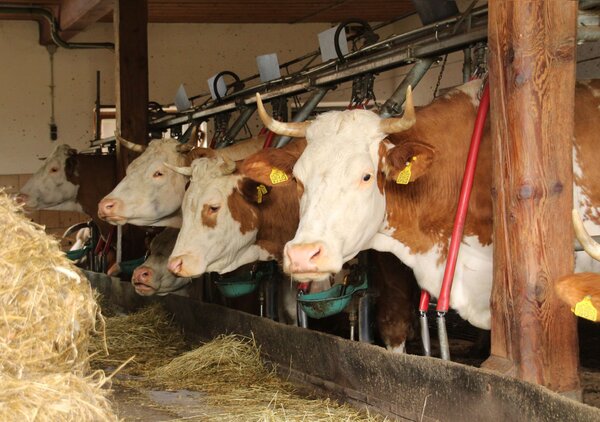Expertise
Tethering in German cattle farming
Hauke Tergast, Sebastian Neuenfeldt, Angela Bergschmidt | 27.07.2023
Dairy cows and cattle housed in tie stalls are tethered continuously or for part of the day. Tie stalls are criticised because they are restricting the natural behaviour of the animals. On the basis of statistical data, the Thünen Institute assessed that around 28,300 cattle farms, equating to 28% of all cattle farms practised this form of husbandry in Germany in 2020. With respect to animal numbers 1.04 Million cattle representing 10% of all cattle were housed in tie stalls.

In its coalition agreement of 2021, the federal government has committed to phase out tethering of cattle. To accurately assess the effects of the ban, the extent of tethering in Germany needs to be determined. To this end, the Thünen Institute analysed the survey data from the Agricultural Census (LZ) 2020 conducted by the Federal Statistical Office.
A total of approximately 1.1 million stabling places in tie stalls and 10.3 million stabling places in loose housing like free stalls were identified. However, the relevance of these statistics is limited. Firstly, it is difficult to determine the exact number of animals that are housed in these stabling places. Secondly, the distinction between year-round and partial tethering was not made. These two variants are evaluated differently in the ongoing debate about a potential tethering ban.
For our analysis, the number of cattle kept on the farms was therefore related to the number of stabling places. In the case of tie stalls year-round and partial tethering was distinguished by using the definition of milch.bayern e. V. according to which partial tethering is characterised by a situation where at least 80% of dairy cows or 65% of "other cattle" have access to an outdoor run for a minimum of 12 weeks per year and/or access to pasture for at least six hours per day during those weeks.
Number of tie stalls in Germany
In 2020, 17,300 farms in Germany, accounting for 35% of all dairy farmers, had tie stalls. On average, these farms are considerably smaller than those practising loose housing, as only 11% of dairy cows are tethered. Year-round tethering is much more prevalent than partial tethering (see to Table 1).
Table 1: Number and shares of dairy cows in the different husbandry systems in 2020
Farms | Share of farms | Animals | Share of animals | |
|---|---|---|---|---|
Free stall | 31.959 | 65 % | 3.348.232 | 89 % |
Tie stall | 17.345 | 35 % | 417.043 | 11 % |
of which: part time tethering | 5.651 | 11 % | 125.569 | 3 % |
of which: year-round tethering | 11.694 | 24 % | 291.474 | 8 % |
In discussions concerning tethering, it is frequently overlooked that not solely dairy cows, but also e.g. beef cattle, are kept in tie stalls. Examination of the LZ data indicates that "other cattle", which is the category in which beef cattle is included are kept in tie stalls in larger numbers than dairy cows. The number of farms with tie stalls is also higher for "other cattle" as compared to dairy cows (refer to Table 2). As with dairy cattle, year-round tethering is more prevalent than partial tethering, and the farms tend to be smaller than the average cattle-keeping farm (Table 2).
Table 2: Number and shares of "other cattle" in the different husbandry systems in 2020
Farms | Share of farms | Animals | Share of animals | |
|---|---|---|---|---|
Free stall | 80.563 | 79 % | 6.459.248 | 91 % |
Tie stall | 21.748 | 21 % | 626.154 | 9 % |
of which: part time tethering | 9.230 | 9 % | 229.272 | 3 % |
of which: year-round tethering | 12.519 | 12 % | 396.882 | 6 % |
The majority of "other cattle" kept in tie stalls are situated on dairy farms. Nevertheless, 9,750 farms, without any dairy cows, maintain 256,000 cattle in tie stalls. This comprises 10% of the farms that keep "other cattle" (4% of cattle).
Throughout Germany, a sum of 28,300 farms keep either dairy cows or "other cattle" in tie stalls and would therefore be impacted by a ban of this housing system. This amounts to 28% of all cattle farms or 10% of all cattle. A prohibition on years-round tethering would impact 17% of farms and 6% of cattle across Germany.
Tie stalls are primarily prevalent in southern Germany, particularly in Bavaria. This is where 52% of farms with tie stalls and 67% of the farms that keep cattle tethered year-round are located. In Bavaria, 43% of all cattle farms keep their animals in tie stalls. Other federal states are affected by the ban to a much lesser degree (see Figure 1).
The majority of tie stalls in Germany are managed by conventional farms. However, organic farms would also be affected by a ban on tethering, although to a much lesser extent (Figure 2).
Compared to cattle farms with loose housing, farms with tie stalls are continued significantly less frequently as part of farm succession. Overall, this means that the proportion of farms with tie stalls will decrease to a greater extent in the future than it is the case for cattle farms as a whole.
Based on the change in farm numbers between 2010 and 2020 and assuming that the observed structural trends continue at an unaltered rate, it is projected that around 9,300 farms with tie stalls (year-round and partial tethering) will still exist in 2032 (see Figure 3).






